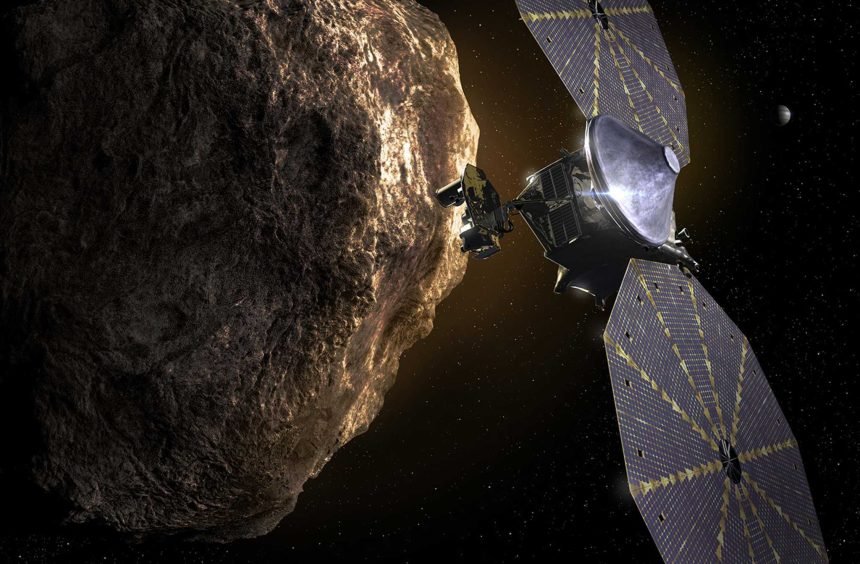This image provided by the Southwest Research Institute depicts the Lucy spacecraft approaching an asteroid. It will be first space mission to explore a diverse population of small bodies known as the Jupiter Trojan asteroids. (SwRI via AP)
A San Antonio research hub and state university could lose a combined $267 million in NASA contracts — forcing the shutdown of space missions already underway — because of Trump administration budget cuts.
The hits to the nonprofit Southwest Research Institute and University of Texas at San Antonio stem from a series of proposed cuts that have space experts, scientists and lawmakers sounding alarms. They say the moves would hobble the space agency and slow the nation’s progress as it’s racing against China to send humans back to the moon.
Article continues below this ad
Under a NASA budget that would slash spending to the lowest level since 1961 — the year it first put an astronaut in space — 62 of the 140 contracts SwRI has with the space agency would be killed. Among the $265.3 million in contracts on the chopping block are several high-profile missions already in space and dozens of studies.
At UTSA, 10 of the institution’s 18 NASA contracts would be cut. The school could lose $1.7 million on the deals for various studies, which have a total value of about $3.7 million.
SwRI officials said the cuts haven’t led to any layoffs but declined to comment further about impacts.
Article continues below this ad
“SwRI will comply with applicable laws and regulations as well as government contractor contractual requirements,” a spokesperson said in a statement.
UTSA has not commented on the potential losses.
SwRI’s space business has grown rapidly in the past decade. It has added staff, tripled the number of researchers working in its Small Spacecraft Development program and built a $35 million, 74,000-square foot space system integration system facility at its West Side headquarters.
In 2022 SwRI created its Space Sector to better organize its work in the fast-growing industry. In 2023, it generated $200 million in revenue, a significant chunk of the institute’s $798 million total that year. Last year, sector revenue was more than $223 million and SwRI says it’s on track to top $260 million this year.
Article continues below this ad
NASA’s proposed cuts could erase nearly one-third of the $915 million in revenue SwRI generated across all its markets last year.
SwRI’s space sector employment is 532. Most of those employees are in San Antonio but 151 work elsewhere, including the institute’s campus in Boulder, Colo., and at the University of New Hampshire.
The cuts target SwRI’s planetary exploration, space weather research — including a mission that launched just last month — and partnerships with the European Space Agency.
Article continues below this ad
Tough year for NASA
NASA has had a rough go under Trump.
Without a permanent leader since December, Secretary of Transportation Sean Duffy has been filling in as interim administrator since July. He’s reportedly been angling to roll NASA into the Department of Transportation.
Billionaire and commercial astronaut Jared Isaacman, an associate of SpaceX CEO Elon Musk, had been the front-runner to lead the agency earlier this year. But when Trump pulled his nomination over concerns Isaacman had previously donated to Democrats, it ratcheted up the tension between the president and Musk ahead of his departure from his budget-cutting role in the Trump administration.
Article continues below this ad
Now, Isaacman is apparently back in consideration for the role and Musk has been taking jabs at Duffy. He’s stepped up his condemnation since NASA reopened the bidding process for Artemis III, its next moon landing mission. It did so saying SpaceX — which currently holds the contract — is unable to meet the required timeline.
“Having a NASA Administrator who knows literally ZERO about rockets & spacecraft undermines the American space program and endangers our astronauts,” he said Wednesday on X regarding Duffy.
More than 4,000 NASA staffers have signed up under Trump administration programs to leave their jobs. The agency also has shuttered its Office of the Chief Scientist as well as several advisory offices.
Article continues below this ad
In July, more than 180 current and former NASA workers signed “The Voyager Declaration,” a letter to Duffy, that voiced opposition to Trump’s handling of the agency and its plans to slash science research.
The proposed budget calls for slashing 47% of NASA’s science spending, bringing it to $4 billion, the lowest level since 1984.
“These proposed cuts would force the premature termination of dozens of missions — fully functioning spacecraft summarily turned off, development work on virtually every future science mission summarily halted,” Bill Nye, a television personality and CEO of the Planetary Society, said this month during a “Save NASA Science” press conference at the U.S. Capitol.
For SwRI, that means several long-running missions studying distant planets, celestial bodies and space weather are facing the ax.
Article continues below this ad
Duffy said the moves are part of a change in strategy at NASA.
“NASA is reprioritizing our focus and resources to provide the most value to the American people,” he told USA Today last week. “The end result will be a leaner, stronger, more focused NASA capable of returning us to the moon and expediting the timeline for an American to plant the Stars and Stripes on Mars.”
Much of the research getting cut is meant to inform future crewed missions but Duffy did not discuss those potential impacts.
“Our top priorities are advancing Artemis, developing the next generation of human landing systems and building the technologies that will carry the first crew to Mars,” he said.
Article continues below this ad
SwRI projects at risk
SwRI could lose $106.4 million on the Lucy mission alone. The spacecraft launched in 2021 on a journey to explore Jupiter’s Trojan Asteroids. NASA now wants to kill the institute’s 19-year, $170.9 million contract to run the mission through 2034.
According to the Planetary Society, NASA has invested $709 million to develop and send the craft to space.
The probe has already explored 11 asteroids, including Donaldjohanson in April, a feat NASA celebrated. It’s set to do its next asteroid flyby in 2027, but that’s at risk if NASA defunds the program.
Article continues below this ad
Other programs facing the ax:
Under a program known as PUNCH, a SpaceX rocket carried four-briefcase sized satellites to space in March. Since April, they’ve been sending back data about the sun’s outer atmosphere and the solar wind that influences space weather. Scientists say data from PUNCH, short for Polarimeter to UNify the Corona and Heliosphere, could help forecast solar events that can threaten power grids, communications, spacecraft and astronauts. NASA wants to end SwRI’s $144.4 million contract to run the program through 2027. It still owes the institute $5.2 million on the deal.
Another, the Magnetospheric Multiscale Mission, a constellation of four SwRI spacecraft studying the sun’s and Earth’s magnetic fields, got an extension in 2021. NASA now wants to end the contracts early. It still owes the institute about $17.2 million on the two deals initially worth $398 million.
Article continues below this ad
In October 2023, SwRI got a $50.8 million contract to develop the Quicksounder satellite to be launched in 2026. In partnership with the National Oceanic and Atmospheric Administration, the weather satellite is expected to help improve forecasting of harmful space weather. As part of NOAA’s new Space Weather Next system, the instruments are to measure the interplanetary magnetic field carried by the solar wind, SwRI said. NASA still owes $3.3 million on the $50.8 million deal.
RELATED: Southwest Research Institute awarded $26M to develop instruments to help predict space weather
SwRI would also lose big on a $60.3 million deal to develop three space weather solar coronagraphs for NOAA. NASA still owes more than $36.5 million on that deal.
The space agency has also targeted the Space Weather Follow On-Legrange 1, a NOAA satellite launched last month to provide continuous space weather observations. NASA owes SwRI $705,000 for that craft.
Article continues below this ad
SwRI built an Ultraviolet Spectrograph for the European Space Agency’s Jupiter Icy Moons Explorer, or JUICE, spacecraft that was sent to space in 2023. At risk is the $21.2 million NASA owes SwRI on the $58.4 million contract for the instrument. The craft is expected to reach Jupiter in 2031, but without funding, the NASA-instrument that SwRI built could be shut off.
NASA also wants to kill several other partnerships with the European Space Agency including the Strofio instrument that’s on the BepiColombo spacecraft currently flying to Mercury, the SPICE instrument on the Solar Orbiter spacecraft studying the Sun’s South pole and the JEDI ultraviolet imager on the Vigil spacecraft that’s set to launch in 2031.
New Horizons, currently the third-furthest spacecraft from Earth, could also get shut off after getting a new lease on life two years ago. Launched in 2006, the 1,000-pound craft is exploring the Kuiper Belt, about 5.5 billion miles from Earth. In 2015, it was the first spacecraft to explore Pluto up close. NASA wants to ax New Horizons after granting it an extension through 2029. The agency still owes SwRI about $14.9 million on a $178.6 million contract for the mission.
SwRI also would lose funding on nearly 50 scientific studies or experiments. They include research on the moon, Mars, Pluto, Europa, Ganymede, solar particles, ocean worlds and planet habitability.
Article continues below this ad
UTSA projects at risk
UTSA is facing the prospect of losing 10 of its 18 contracts with NASA. The fast-growing research institution could lose out on $1.7 million in funding still on the table as part of the deals worth about $3.7 million.
On the chopping block are studies that look at managing rocket plumes on the lunar surface, developing technologies for landing on Mars and Titan, modeling Venus’s pancake domes, solar energetic particles, planetary data archiving, advanced propulsion systems, planetary materials and Europa’s atmosphere.
NASA also wants to cancel funding to operate a station that monitors air quality and the composition of the atmosphere. NASA has already paid $479,788 on the $590,017 program originally scheduled to run through 2027. UTSA students operate the station, which is part of NASA’s Pandora Project that began in 2005. It’s part of a global network and partnership with the ESA called the Pandonia Global Network.
Article continues below this ad
UTSA’s largest contract at risk is a $1.2 million program “to attract diverse groups of students to STEM through learning opportunities that connect to NASA’s mission and work,” that began last month. So far, NASA has paid $399,547 on the program.
According to the Planetary Society, the hits to NASA’s science divisions are forcing “premature terminations of active missions, massive cuts to fundamental scientific research and the end of dozens of projects currently being designed and built.”
The nonprofit society co-founded by Carl Sagan works to advance space exploration.
Article continues below this ad




















